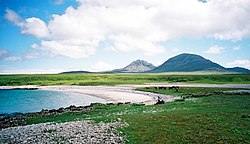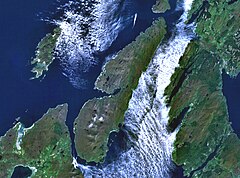Jura
| Jura Gaelic: Diùra | |
 Traigh nam Feannag | |
|---|---|
| Main village: | Craighouse |
| Location | |
| Location: | 56°4’59"N, 5°45’0"W |
| Grid reference: | NR589803 |
| Area: | 142 square miles |
| Highest point: | Beinn an Òir 2,575 feet |
| Data | |
| Population: | 188 |
Jura is a large island and parish of Argyll, in the Inner Hebrides, lying in the sea to the north-east of Islay.
Until the twentieth century Jura was dominated, and most of it owned, by the Duke of Argyll, chief of the Clan Campbell. However, during the first half of the twentieth century the Campbells gradually sold the island as a number of separate estates. Part of the island is designated as a National Scenic Area.
Contents
History
Evidence of settlements on Jura dating from the Mesolithic period was first uncovered by the English archaeologist John Mercer in the 1960s. There is evidence of Neolithic man at Poll a' Cheo in the southwest of the island. The modern name "Jura" dates from the Norse-Gael era and is from the Old Norse Dyrøy meaning "animal island".[1]
In 1549, Donald Munro, Dean of the Isles wrote that the island was "ane ather fyne forrest for deire, inhabit and manurit at the coist syde", with "fresche water Loches, with meikell of profit" and an abundance of salmon.[2] At this time Jura was in the hands of Clandonald of Kintyre, Clan Macfie of Colonsay, Maclean of Duart and Maclean of Lochbuie.[2]
Geography
With an area of 142 square miles, and only 188 inhabitants recorded in the 2001 census, Jura is much less densely populated than neighbouring Islay and is one of the least densely populated of the larger islands of Britain.
The main settlement is the village of Craighouse on the east coast. Craighouse is home to the island's sole distillery, producing Isle of Jura whisky.[3] The village is also home to the island's only hotel, shop and church.
The chief link to Jura is from the neighbouring island of Islay: a small car ferry operates across the Sound of Islay between Port Askaig on Islay and Feolin Ferry on Jura. In the summer there is also a passenger service between Craighouse and Tayvallich on the mainland. From Feolin Ferry a single track road follows the southern and eastern coastline of the island. To the north of Craighouse the road leads to Lagg, Tarbert, Ardlussa and beyond. A private track runs from the road end to the far north of the island.
The west coast of Jura has no permanent inhabitants, but is home to a number of raised beaches. Between the northern tip of Jura and the island of Scarba lies the Gulf of Corryvreckan where a whirlpool makes passage dangerous at certain states of the tide. The southern part of the island, from Loch Tarbert southwards, is one of 40 National Scenic Areas in Scotland.[4]
Estates
Jura now comprises six estates which are all in separate ownership: Ardfin, Inver, Jura Forest, Ruantallain, Tarbert, and Ardlussa.
The Ardfin estate is situated at the southern tip of the island, between Feolin and Craighouse. It includes the 16-bedroom C-listed Jura House, whose famous and beautiful walled gardens benefit from a southerly aspect and the effects of the Gulf Stream. The gardens are home to exotic specimen plants from Australasia. These were, for some years, a popular tourist attraction on the island though they have been closed since a new owner acquired the estate in 2010. The estate also includes 10 miles of coastline and seven islands over a total of 11,595 acres.[5]. In November 2010 the Ardfin Estate was bought by Greg Coffey, an Australian hedge-fund manager.[6] He instructed that the gardens should be closed to the public. By May 2011 Coffey had yet to visit his property since its acquisition, and the ongoing closure of the gardens was becoming an increasing cause for concern among the island's residents.,[7]
Wildlife
The island has a large population of red deer and it is commonly believed that the name Jura was derived from hjǫrtr, the Old Norse word for deer. (In Old Norse dýr meant "animal" and was a euphemism for hjǫrtr, as this was a sacred and tabooed word.) Much of the island is used for deer stalking, and visits by stalking parties have become a significant source of employment and a contributor to the island's economy.[8]
The deer prevent the island from tumbling back down to woodland, as was its former state; indeed, before the clearances and abundance of deer, the isle's name was thought to come from 'the great quantity of yew trees which grew in the island'.[9]
Paps of Jura
- Main article: Paps of Jura
The island is dominated by three steep-sided conical quartzite mountains on its western side – the Paps of Jura which rise to 2,575 feet. As the name suggests, the Paps are delightfully anatomical in their aspect, and would be more so were there just two of them.
The three hills are:
- Beinn an Òir (mountain of gold), standing at 2,575 feet
- Beinn Shiantaidh (holy mountain) at 2,477 feet
- Beinn a' Chaolais (mountain of the kyle), at 2,408 feet
The Paps dominate the landscape in the region and can be seen from the Mull of Kintyre and, on a clear day, Skye and County Antrim. The route of the annual Isle of Jura Fell Race includes all three of the Paps of Jura and four other hills.
These hills were the subject of William McTaggart's 1902 masterpiece The Paps of Jura,[10] now displayed in the Kelvingrove Art Gallery and Museum.[11]
Culture
Like all of the inhabited Hebridean islands, Jura has its own indigenous tradition of Gaelic song and poetry.[12][13]
Towards the north end of Jura, some miles beyond the end of the metalled road, is Barnhill, the remote house where the novelist George Orwell spent much of the last three years of his life. Orwell was known to the residents of Jura by his real name, Eric Blair. It was at Barnhill that Orwell finished Nineteen Eighty-Four, during 1947–1948 while critically ill with tuberculosis.[14] He sent the final typescript to his publishers, Secker and Warburg, on 4 December 1948, who published the book on 8 June 1949.[15]
Gaelic on Jura
Gaelic has suffered a major decline over the last 200 years. The 1881 census reported that 86.6% (out of 946 inhabitants) spoke Gaelic. In 1961, for the first time less than half (46.9%) spoke the language and by 2001, this figure had dropped to 10.6%.
In fiction
Jura is featured in the plot of the 2007 novel The Careful Use of Compliments by the Edinburgh writer Alexander McCall Smith.
Jura is also briefly mentioned in the Galactic Milieu series by Julian May.
Jura is a setting for some of the narrative and action in Anne Michaels' novel 'The Winter Vault', 2008.
In music
Jura is mentioned in: "Crossing to Jura", a song by R. Kennedy and D. MacDonald, recorded in 1997 by JCB with Jerry Holland on the album "A Trip to Cape Breton"; "The Bens of Jura", a song by Capercaillie; and "Isle of Jura", a song by Skyclad.
The 2010 album 'Poets and Lighthouses' by Tuvan singer Albert Kuvezin of the band Yat Kha was recorded and produced by the British musician Giles Perring on Jura, with some of the performances being recorded in the forest at Lagg. The album reached Number 1 in the European World Music Charts in Jan 2011.[16]
References
- ↑ Haswell-Smith (2004) p. 47
- ↑ 2.0 2.1 Monro (1549) "Duray" No. 15
- ↑ isleofjura.com Retrieved 2010-07-18.
- ↑ "National Scenic Areas". SNH. Retrieved 30 Mar 2011.
- ↑ Heffron, Mike (4 August 2010) "Much more than a house". Glasgow: The Herald
- ↑ Aussie stars shine in funds revival | The Australian
- ↑ Cowing, Emma (15 May 2011). "Everything in Jura's garden far from rosy". The Scotsman (Edinburgh). http://news.scotsman.com/scotland/Everything-in-Jura39s-garden-far.6768425.jp.
- ↑ http://www.theisleofjura.co.uk/index%20files/Emedia/The%20Jura%20Economic%20Study.pdf The Jura Economic Survey, 2005. Retrieved 2009-10-17
- ↑ Statistical account of Scotland - Account of 1791-99 vol.12 p.318
- ↑ "William McTaggart". Machrihanish Online. http://www.machrihanish.net/Machrihanish_McTaggart.html. Retrieved 2007-04-04.
- ↑ "Kelvingrove Art Gallery". planetware.com. http://www.planetware.com/glasgow/kelvingrove-museum-art-gallery-sco-stra-glamus.htm. Retrieved 2007-04-04.
- ↑ Simon Ager. "Toirt m' aghaidh ri Diùra". Omniglot. http://www.omniglot.com/songs/gaelic/ohuiribh.php. Retrieved 2008-11-09.
- ↑ "Da Thaobh Loch Seile". all celtic music. http://www.allcelticmusic.com/music/5b7c6292-f86f-102a-8020-000f1f67beb1/Da+Thaobh+Loch+Seile.html. Retrieved 2008-11-09.
- ↑ Bowker, Gordon (2004). George Orwell. London: Abacus. ISBN 0316861154.
- ↑ Bowker (2004) p. 383, 399.
- ↑ Mongolian throat singer Kuvezin is the latest pride of Jura - Herald Scotland | News | Home News
Books
- Haswell-Smith, Hamish (2004). The Scottish Islands. Edinburgh: Canongate. ISBN 1841954543.
Outside links
- The Isle of Jura - Feolin Centre - World's largest collection of Jura information
- Isle of Jura Isle of Jura Information, Images and Jura Blog
- Jura on Scotlandview Isle of Jura Pictures and Comprehensive info
- Orwell's life on Jura


